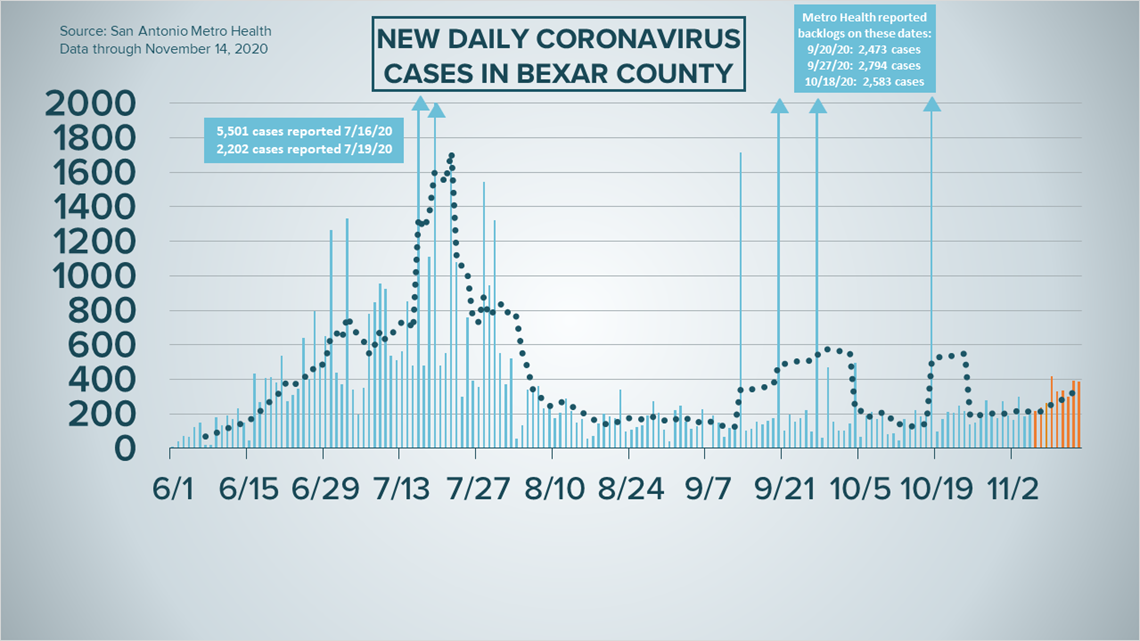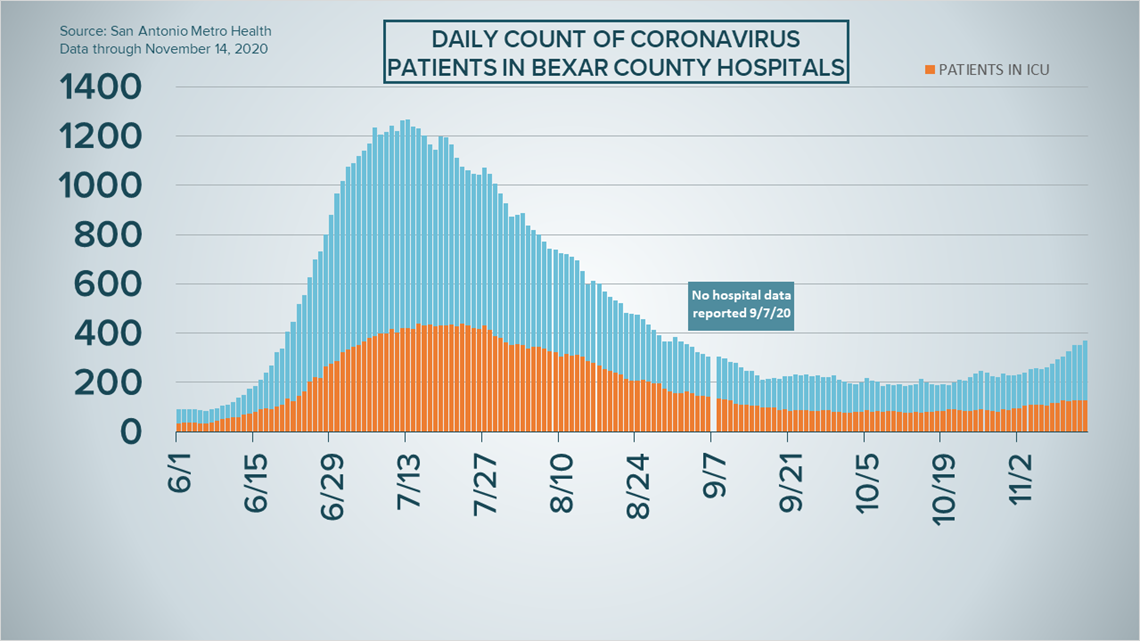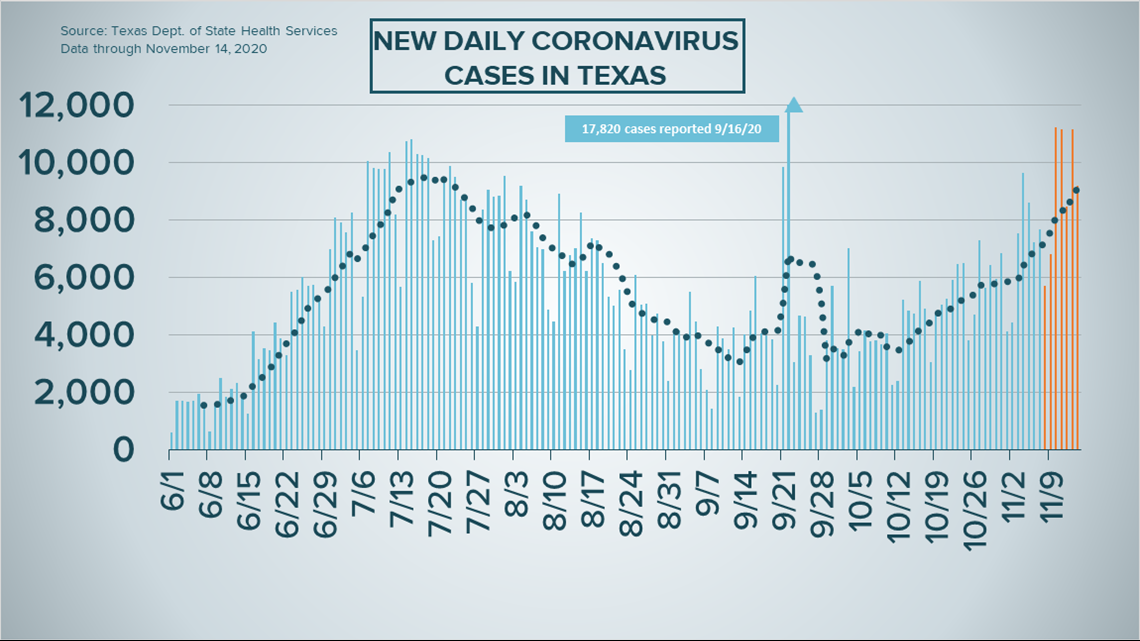SAN ANTONIO — We're tracking the latest numbers from the coronavirus pandemic in San Antonio and across Texas. Here are the latest numbers reported by Bexar and surrounding counties:
- Bexar County: 389 new cases were reported Saturday, bringing the total number of cases for the county to 69,793. One new death was also reported, bringing the death toll to 1,294.
- Comal County: The county reported 64 new COVID-19 cases Friday as well as 21 backlogged cases. No new virus-related deaths were reported. There have been a total of 4,093 reported cases of COVID-19 in the county – including 2,994 lab-confirmed cases – while 124 county residents have died. County officials say there are 266 active coronavirus cases, and 3,703 residents are considered recovered.
- Hays County: Officials in Hays County on Friday reported 45 new cases in the county and no additional virus-related deaths. As of Friday, there are a total of 6,616 lab-confirmed cases in the county (511 of which are active), while the death toll remained at 91. 6,014 residents have recovered from the virus.
How Bexar County is trending
We've tracked how many coronavirus cases have been confirmed in Bexar County from the time officials began reporting cases in March 2020. The graphic below shows the number of cases since June and charts those daily case numbers along a 7-day moving average to provide a more accurate picture of the overall coronavirus case curve in our area and the direction we're trending amid the pandemic.
San Antonio Metro Health reported an additional 389 coronavirus cases in Bexar County, bringing the total number of local infections to 69,793 since the pandemic began. The county's seven-day moving average for newly reported cases is now 346 per day.


One new death was reported Saturday, bringing the total number of Bexar County residents who have died from COVID-19 complications to 1,294.
Meanwhile, the number of local COVID-19 patients hospitalized rose to 371 on Saturday. Of the 371 patients, 60 are on ventilators and 129 are in ICU.


Coronavirus in Texas
The total number of novel coronavirus cases in the state since the pandemic began grew by 9,177 on Saturday, according to the Texas Department of State Health Services. That rise includes 296 cases attributed to backlogs that were previously not included in the state's total. 108 were removed from the total due to accidental overreporting by McCulloch County (More details can be found at the top of this page.)
The state's 7-day moving average for newly reported cases is now 8,871. The peak 7-day average during July's COVID-19 surge was 9,469 new cases per day on July 17.
As of Saturday, at least 1.055 million Texans have contracted COVID-19. This includes 1,014,160 cases confirmed positive by PCR molecular testing as well as 40,473 antigen-positive cases as reported by DSHS.


State health authorities also reported 150 additional virus-related deaths on Saturday. Friday brought the highest number of fatalities reported in over two months, when 177 deaths were reported on September 5.
At least 19,470 Texans have passed away from COVID-19 complications.
Meanwhile, the overall number of Texans hospitalized for COVID-19 on Saturday rose by 68, bringing the current total to 7,151. On Friday, that number passed 7,000 for the first time since early August.
Since the beginning of the week, the number of Texas hospitalizations have gone up by 17.6%, continuing a trend that began in early October that indicates a resurgent virus spread in the Lone Star State.
The state estimates that 861,205 Texans have recovered, while 135,912 Texans remain ill with COVID-19.
Meanwhile, the latest update from the Texas Education Agency showed that there have been 39,291 cumulative cases among staff and students across the state through Nov. 8. More information can be found here.
The TEA releases new data on school cases every Thursday.
Latest Coronavirus Headlines
- Biden faces tough choice of whether to back coronavirus lockdowns
- Surging coronavirus cases get a shrug in many Midwestern towns
- 184,000 new US COVID-19 cases Friday; On pace for 1 million this week alone
- House Democrats criticized for new member indoor dinner plans during COVID-19 spike
- More than 300 Texas hospitals to receive 'bamlanivimab,' experimental antibody treatment for COVID-19
- AP FACT CHECK: Trump's claims on Pfizer coronavirus vaccine, state distribution
- Reports: More than 100 Secret Service agents out with COVID-19 or in quarantine
Coronavirus symptoms
The symptoms of coronavirus can be similar to the flu or a bad cold. Symptoms include fever or chills, cough, shortness of breath or difficulty breathing, fatigue, muscle or body aches, headache, new loss of taste or smell sore throat, congestion or runny nose, nausea or vomiting and diarrhea, according to the Centers for Disease Control.
Most healthy people will have mild symptoms. A study of more than 72,000 patients by the Centers for Disease Control in China showed 80 percent of the cases there were mild.
But infections can cause pneumonia, severe acute respiratory syndrome, kidney failure, and even death, according to the World Health Organization. Older people with underlying health conditions are most at risk.
But infections can cause pneumonia, severe acute respiratory syndrome, kidney failure, and even death, according to the World Health Organization. Older people with underlying health conditions are most at risk.
Experts determined there was consistent evidence these conditions increase a person's risk, regardless of age:
- Chronic kidney disease
- COPD (chronic obstructive pulmonary disease)
- Obesity (BMI of 30 or higher)
- Immunocompromised state (weakened immune system) from solid organ transplant
- Serious heart conditions, such as heart failure, coronary artery disease, or cardiomyopathies
- Sickle cell disease
- Type 2 diabetes
The CDC believes symptoms may appear anywhere from two to 14 days after being exposed.
Human coronaviruses are usually spread...
- Between people who are in close contact with one another (within about 6 feet).
- Through respiratory droplets produced when an infected person coughs, sneezes or talks. These droplets can land in the mouths or noses of people who are nearby or possibly be inhaled into the lungs.
- Some recent studies have suggested that COVID-19 may be spread by people who are not showing symptoms.
Help stop the spread of coronavirus
- Stay home when you are sick.
- Eat and sleep separately from your family members
- Use different utensils and dishes
- Cover your cough or sneeze with your arm, not your hand.
- If you use a tissue, throw it in the trash.

